| Islamic Patterns
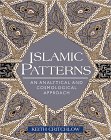 I bought this amazing book back in the late 70s. It's Islamic Patterns : An Analytical and Comsmological Approach by Kenneth Critchlow. It's back in print for those who didn't get it the first time around. I bought this amazing book back in the late 70s. It's Islamic Patterns : An Analytical and Comsmological Approach by Kenneth Critchlow. It's back in print for those who didn't get it the first time around.
This isn't a book of cute patterns. The Introduction opens...
"Know, oh brother..., that the study of sensible geometry leads to skill in all the practical arts, while the study of intelligible geometry leads to skill in the intellectual arts because this science is one of the gates through which we move to the knowledge of the essence of the soul, and that is the root of all knowledge..."
From the Rasa'il by the Brotherhood of Purity, translated by S. H. Nasr
(...)
In Chapter 1 we show illustrations of these first moves into the dimensions, starting with a luminous point; the first line is the extension from this point. The limits of this extension having been reached, rotation takes place to encompass the next domain--an area. With this enclosure formed, a cycle is completed, a 'world' in the form of a circle. The circle becomes the archetypal governing basis for all the geometric shapes that unfold within it, this two-dimensional world being one dimension nearer to the origin that is our solid 'world.' The circle's primary inherent quality is one of 'sixness'; as will be demonstrated in terms of the radius and its relationship to the circumference.
From the basic circle and the hexagonal arrangement of a group of tangential circles of the same radius surrounding it emerge the three primary shapes: the triangle, the hexagon and the square. These three shapes are explored in detail to reveal their inherent structure, subdivision, proportional ratios and interrelatedness. From this last, which can be called the 'sociability' of the polygons, arises the set of eight semi-regular divisions of a surface, that is combinations of 3's, 6's and 4's in repeating patterns. These eight tesselations form the basis and the mathematical foundations of the laws of repetition upon which Islamic geometrical art is founded.
The book shows how these patterns are constructed. When I first read the book I realized that I would have to construct these patterns to really understand them. I spent 20 years as a drafter which is one of the reasons for my fascination with this. I was also an architecture student for a couple of years and that opened my eyes to Isamic art and architecture. I tried drawing them on the board but that was too limiting. I knew I wanted to draw them in a CAD (Computer Aided Design) program. I had been using CAD programs since 1979.
I use Photoshop and Illustrator a lot. Photoshop is a raster graphics program. Everything is pixels. Illustrator is a vector graphics program. Everything is defined mathematically. There are no pixels. However, Illustrator doesn't know where it is. You can't draw things to scale. A CAD progam can. Everything is drawn in a coordinate system. A line is defined by its end points in a cartesian coordinate system. That means it is easy for the CAD program to locate the mid point and end points of a line for constructing geometry. Like the the geometry in Islamic patterns.
I discovered TurboCad this summer. They are giving it away. Of course it doesn't have all the features of the full version which has expanded 2D capabilities as well as 3D. But what it has is light years beyond what I was using in 1979 which cost $250,000 for a four terminal turnkey system that had to be in an air conditioned room with the big reel to reel tape drives for archiving. Their full version is $100 and their full solid modeling package is $400. Amazing. So I started drawing some of these patterns.
Once I had drawn them I wanted to play with them but the CAD program is limited to some primitive coloring. This morning I was playing with Illustrator and found out that it will read .DWG and .DXF files which are common AutoCAD formats that TurboCad supports. Eureka! So I put one of my patterns into Illustrator. Layers and colors all came accross as well as all the geometry and groups. Hot damn!
So, here is what I am talking about. This shows the basic geometry underlying this particular pattern.
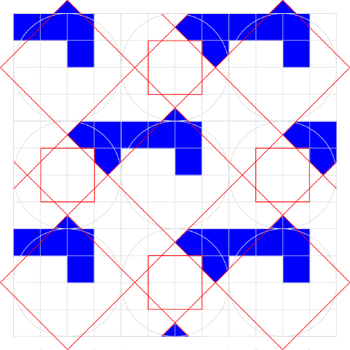
It starts with a point. Then a radius and a circle. The circle is squared and quartered. The square is repeated horizontally and vertically to create a 3x3 grid. The gray lines are the basic structure. The red lines are the secondary structure that the pattern is built on. The blue polygons are the basic repeating shape constructed from elements of the primary and secondary structure.
The finished pattern looks like...
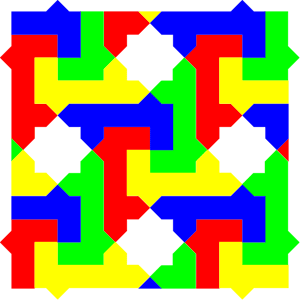
That is as far as I got with TurboCad. I can do a lot more in Illustrator. This is a study playing around with the above pattern. I wanted to devolve the pattern and play with some of the elements like this...
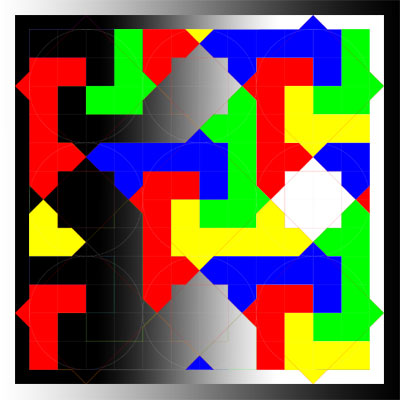
This is really meant to be printed. It's hard to see some of the detail. So here is a detail...
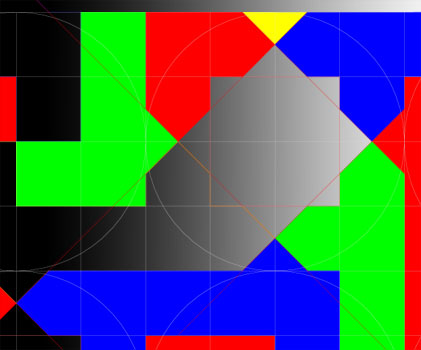
This is fun stuff!
Beaver Report - Day 10
As I predicted, there was no beaver activity today. There should be a lot tomorrow.
TestingTesting
Monday night is TestingTesting, the webcast I do from my living room. So there won't be much activity here until Tuesday. But click on in Monday night and listen to some great music.
|

